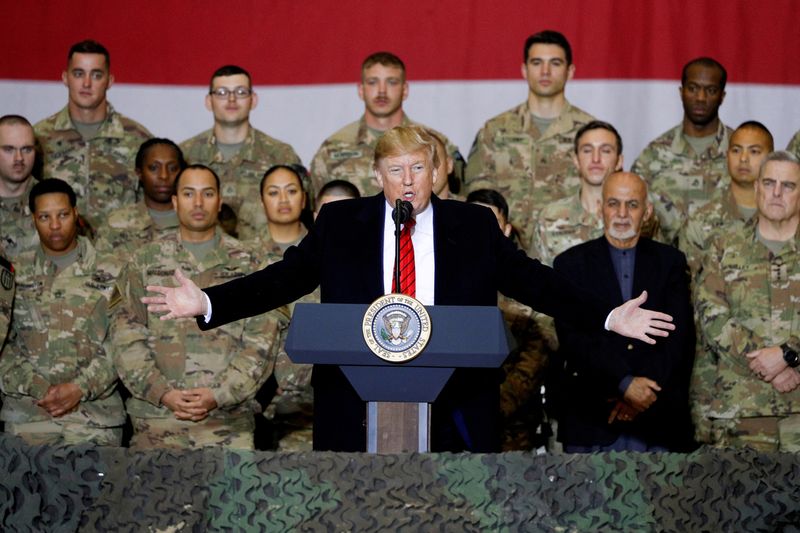(This April 6 story has been corrected to say that 124,000, not 100,000, people were flown out of Kabul in paragraph 18)
By Nandita Bose and Jonathan Landay
WASHINGTON (Reuters) - President Joe Biden's administration on Thursday released a summary of classified reports that mostly blamed the chaotic August 2021 U.S. pullout from Afghanistan on his predecessor, Donald Trump, for failing to plan for the withdrawal he had agreed on with the Taliban.
The Democratic administration's summary, drawn from top-secret State Department and Pentagon reviews sent to Congress, ignited angry reactions from Republican lawmakers who have demanded the documents for their own investigation of the pullout.
Michael McCaul, the Republican chairman of the U.S. House of Representatives Foreign Relations Committee, strongly criticized the administration. Biden ordered the pullout and was "responsible for the massive failures in planning and execution," McCaul said in a statement.
McCaul, who is overseeing the Republican probe, charged that his multiple threats to subpoena the State Department and Pentagon reviews, which were completed last year, finally compelled the administration to send them to Congress.
"President Biden’s choices for how to execute a withdrawal from Afghanistan were severely constrained by conditions created by his predecessor," said the summary of the reviews. "The outgoing administration provided no plans for how to conduct the final withdrawal or to evacuate Americans or Afghan allies."
The document acknowledged that the administration learned lessons from the withdrawal, and now errs on the side of "aggressive communication" about risks in a destabilized security environment.
CHAOTIC END TO AMERICA'S LONGEST WAR
The withdrawal that ended America's longest war saw tens of thousands of Afghans desperate to flee a return of hardline Taliban rule besiege Kabul's international airport, some handing babies to U.S. troops or breaking in and hanging onto departing aircraft.
The Trump administration also "gutted" refugee support services and virtually halted the processing of Special Immigration Visas for thousands of Afghans seeking evacuation because they worked for the U.S. government, leaving a massive backlog, the summary said.
"Transitions matter. That's the first lesson learned here. And the incoming administration wasn't afforded much of one," National Security Council spokesman John Kirby (NYSE:KEX) told a White House briefing.
The 12-page summary placed some responsibility for the chaos of the pullout and evacuation operation on flawed U.S. intelligence and military assessments that failed to foresee the speed of the Taliban takeover and predicted that Afghan security forces would hold Kabul.
"As late as May 2021, the assessment was still that Kabul would probably not come under serious pressure until late 2021 after U.S. troops departed," the summary said.
Pressed on whether Biden bore any responsibility for the Kabul airport disorder, Kirby replied, "Just by dint as the commander in chief, he assumed responsibility for the orders he gives."
WITHDRAWAL POSTPONED
The 20-year war in Afghanistan, the longest conflict involving U.S. troops, was started under President George W. Bush and furthered under President Barack Obama. Over 100,000 people were killed and about 3 million displaced, according to data from the nonpartisan Costs of War project at Brown University.
Biden pledged during his 2020 campaign to end "forever wars" and withdraw from Afghanistan, although he postponed the pullout to which Trump had agreed by three months until the end of August 2021. The U.S.-backed Kabul government collapsed on Aug. 15 as the Taliban were entering the city.
The disorganization and chaos as the U.S. left raised questions about Biden's leadership, the quality of U.S. intelligence and America's commitment to human rights and thousands of Afghan citizens it had relied on.
An Islamic State suicide bomber on Aug. 26, 2021, killed 13 U.S. service members and 170 Afghans as they clustered outside a gate of the airport.
Thousands of American citizens, greencard holders, and Afghans who had applied for Special Immigration Visas were unable to leave on the largest U.S. airlift on record.
Altogether, some 124,000 Americans, greencard holders and Afghans - many of whom were not vetted - were flown out before the U.S. withdrawal ended just shy of the 20th anniversary of the U.S.-led invasion of Afghanistan.
The Trump administration agreed in a February 2020 accord with the Taliban on the pullout of all U.S.-led international forces by May 2021. The Islamist militants agreed to stop attacking American troops and hold peace talks with the Western-backed Kabul government.

In laying out the withdrawal chronology, the summary said that successive troop reductions ordered by Trump had left 2,500 U.S. troops in Afghanistan when Biden took office in January 2021. The result was that the Taliban controlled or contested half the country, the summary said.
Faced with the choice of delaying the pullout or increasing the number of U.S. forces and facing renewed Taliban attacks, Biden chose the former and ordered planning for the withdrawal and evacuation operation, the summary said.